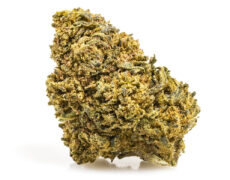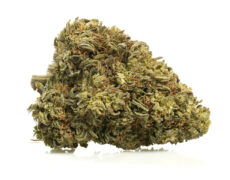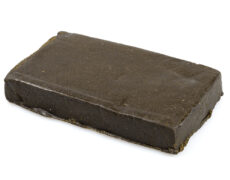Modified on: 13/11/2023
Everything you need to know about the cannabis munchies effect
The article we are going to discuss is about the effect cannabis has on appetite and in particular the phenomenon of munchies, or the urge to consume calorie-rich food that occurs after marijuana consumption.
In this article, we will discover how THC, the active ingredient in cannabis (present in CBD legal products, such as CBD flowers, at levels of less than 0,2% in accordance with legal regulations), acts on our brain to alter the perception of appetite and what consequences this effect can have on our health. We will also provide tips on how to manage the effects of munchies and suggest five healthy foods to try when under the influence of cannabis.
Read on to find out everything you need to know about the cannabis munchies effect.


What is chemical hunger and why smoking cannabis makes you hungry
Those who have taken soft drugs such as cannabis or hashish at least once in their lives are familiar with what chemical hunger – also known as the chemical hungry or more familiarly munchies effect – means and what its direct consequences are.
It is in fact a sudden condition that tends to occur quite naturally after smoking and which leads to an alteration in the perception of the sense of hunger and consequently of satiety, consequently stimulating the impelling need to consume food that is predominantly substantial and rich in calories, a symptom that tends to appear between 30 minutes and 2 hours after consumption, subsiding only after the intake of a purely subjective amount of nourishment that the organism itself considers sufficient.
More than ten thousand scientific studies carried out over the last few years have amply demonstrated how cannabis affects the appetite, and while we are in fact dealing with a purely neurological and in many respects still unclear phenomenon, in order to fully understand what munchies are, we must first understand their causes and symptoms.
The cause of munchies is THC, the active ingredient in cannabis, which literally ‘tricks’ the brain into altering the perception of hunger through the sense of smell.
According to a group of researchers at the Yale School of Medicine in New Haven, Connecticut, cannabinoids stimulate the neurons normally responsible for suppressing appetite, but in the opposite way.
Moreover, an American study has identified the links between marijuana consumption and appetite; this study offers a broad explanation of the effects of chemical hunger in properly scientific terms by analysing its dynamics: the neurons deputed to the synthesis of the pro-hormone pro-opiomelancortin or POMC, stimulated by the cannabinoids naturally present in cannabis, would arouse the subject’s appetite even though they are intended to ensure the organism a common sense of satiety at the end of the meal.
In short, the brain system that controls eating is tricked by the action of THC, according to research group coordinator Tamas Horvarth.
Further investigation therefore led the researchers to a single conclusion: at the very moment when the POMC neurons are activated by cannabinoids, they stop releasing the characteristic anorectic hormones that determine satiety and normally quench hunger, retaining only the neurotransmitter beta endorphin, responsible for the typical general sense of well-being.
According to a French-Italian study on munchies, there is also a real olfactory factor present in the Cb1r receptor.
This receptor, which is also present in the neurons of the olfactory bulb – the section of the brain responsible for receiving stimuli from the nose – would, when stimulated by THC, amplify its normal activity, causing an increased sensation of appetite.
Munchies: how long they come, how long they last and how to manage them
As a rule, munchies tend to occur within a time frame that can vary from 30 minutes to about 2 hours after intake, subsiding only through the intake of particularly nutritious food.
However, this condition is as purely subjective as it is indicative because, although there are very few scientific studies to support it, there are many variables that can influence its onset.
The constitution of the subject plays an important role, but the type of cannabis consumed is equally decisive: each species contains a variable, often very concentrated percentage of THC, which can certainly significantly exacerbate the sense of hunger.
The mode of intake itself is crucial to both the effects and the extent of the munchies. It goes without saying that the munchies caused by consuming cannabis through so-called edibles or edible preparations will be far less impactful than a ‘classic joint’.
Even more so when compared to consumption by vaping.
Knowing, therefore, how to resist munchies, allows one to curb the effects that such a condition may cause on the body, starting with the probable weight gain due to the ingestion of caloric and predominantly sweet foods.
The first solution to be implemented is certainly to set up a complete and satisfying food regime linked to the main meals of the day, including any ‘snack breaks’: going to smoke on a full stomach or in any case previously satisfied by food does not eliminate the problem of munchies at the root, but at least it reduces the consequences, leading to the ingestion of less food than if the stomach were completely empty.
If, on the contrary, the munchies persist even after satisfying the stomach, it is important to try to divert attention away from food in some way, through alternative activities that can positively occupy the mind.
A walk, a bike ride, a good read or simple physical activity in the gym will allow you to reap all the benefits of a pleasant recreational activity, reducing the desire to consume food that the body objectively does not need.
The ideal is always to resort to the so-called plot twist, which consists of exercising before taking cannabis in order to burn sufficient calories to compensate for those later consumed due to the effects of the munchies.
Once again, going to the gym, practising yoga, running, crossfit or any other metabolism-boosting activities are ideal for controlling weight and avoiding an increase in extra kilos.
A further alternative may be to change the type of cannabis taken: in order to reduce munchies, it is advisable to prefer a high concentration of CBD or THC to THCV, active ingredients that in any case make it possible to be equally satisfying while smoking, without causing unpleasant deleterious effects on the appetite.
In this case, one proceeds a little by trial and error, experimenting with the various types of inflorescences until one finds the one that is most pleasurable and able to satisfy one’s intended goals.
If introducing food should prove to be an irresistible urge, it is better to reduce the effects by trying to appease the hunger with light snacks or at least predominantly healthy foods consisting of fruit and vegetables. In this way, you will not have to give up the pleasure of smoking but at the same time you will not suffer the less than pleasant effects of probable indigestion!


5 foods to try when you are high
Who says that eating healthy can’t be just as appetising?
Whether starving or not a healthy diet should be a priority. A mix of colours, scents and natural flavours that, with a pinch of imagination, result in delicious meals.
1. Dried fruit as if it rained
Mistakenly consumed only during the holidays, dried fruit is a food to be enjoyed daily. Nutritionists recommend between 15-30 grams a day for their excellent properties.
Indispensable for those on a vegetarian diet and beyond, nuts are rich in vegetable proteins, vitamins, dietary fibre, which stimulates intestinal transit and has an anti-cancer function, and omega 3 and omega 6 essential fatty acids.
But there is more.
Whether nuts, hazelnuts or cashews, dried fruit is perfect for feeding our uncontrollable hunger. Why? Because of its high fibre content, which is closely related to the feeling of satiety.
2. Mango and fresh fruit
Essential for health, fresh fruit with a focus on mango, is the ideal snack for when we have smoked pot.
With countless benefits, the WHO (World Health Organisation), associates around 1.7 million deaths a year with low fruit and vegetable consumption and recommends a minimum of 5 portions every day.
Naturally rich in fibre and therefore perfect for satiating us, we never go wrong with fruit. Suitable for the lazy, fruit requires no preparation and there are literally an infinite number of colours and flavours to explore.
Finally, mango is the favourite choice of the cannabic community because of the phantom powers it can have on stonedness. It is rumoured that this fruit, due to its high content of myrcene, a terpene also found in cannabis, can enhance the effects of marijuana on us.
It does no harm to try.
3. Yoghurt
Either eaten plain or enriched as we like, yoghurt is the ideal alternative to avoid junk food. Satiating and nutritious, there is something for every taste and every need.
From Greek yoghurt to soya yoghurt, perfect for those following a vegan diet but not only, it is a beneficial food rich in probiotics for our intestines and often with added vitamin B12.
4. Crunchy muesli
Having breakfast with crunchy cereal or muesli is always nice. To be drowned in cups of milk, added to yoghurt or simply munched on, these cereals are a tasty snack suitable for any time of day or night. But beware.
Often times these cereals are really unhealthy, because they are full of added sugars and artificial ingredients. When we launch ourselves with our trolley into the cereal aisle, we are more scrupulous and are sure to find the perfect combination of simple, healthy and delicious.
5. An amazing mix
After smoking marijuana our chemical hunger is uncontrollable and not even the foods listed above will be enough to calm it down?
The solution is to grab a cup or bowl and let our imagination run wild. This is an example:
- Take my mug and pour a base of yoghurt
- Enrich it with some breakfast cereal
- Top it with chopped seasonal fruit
- Add chia or flax seeds
- Add some chopped dark chocolate
Read also: How to know if my weed is good quality? Here’s everything you need to know
Conclusions
The article discusses the phenomenon of chemical hunger, or munchies, experienced by people who smoke cannabis (do not mistake it for CBD cannabis!). It explains that the active ingredient in cannabis, THC, affects the appetite by tricking the brain into altering the perception of hunger through the sense of smell.
The article also provides tips on how to manage the effects of munchies, such as setting up a satisfying food regime, exercising, and changing the type of cannabis consumed. Additionally, it lists five healthy foods to try when experiencing the munchies, including dried fruit, fresh fruit, yogurt, crunchy muesli, and a mix of yogurt, cereal, fruit, seeds, and dark chocolate.
💡Takeaways about the food to eat when you are under cannabis effect
- Chemical hunger, or munchies, is a phenomenon that can occur after smoking cannabis or hashish and is characterised by an alteration in the perception of hunger and satiety, prompting one to consume large, calorie-rich foods.
- THC, the active ingredient in cannabis, is the cause of munchies, as it stimulates the neurons normally responsible for suppressing appetite in the opposite way, creating the sensation of hunger.
- The way cannabis is administered affects the extent and duration of munchies: for example, those caused by ordinary ‘joints’ are more intense than those caused by edible preparations.
- It is possible to manage munchies, for example, by planning a complete and satisfying diet, engaging in physical activity or changing the type of cannabis consumed.
- In the case of munchies, you can try to satisfy your hunger with healthy foods such as dried fruit, fresh fruit, yoghurt, crunchy muesli or a mixture of yoghurt, cereals, fruit, seeds and dark chocolate.
FAQ about the food to eat when you are under cannabis effect
What is chemical hunger and why smoking cannabis makes you hungry?
Chemical hunger, also known as munchies, is a sudden condition that occurs after smoking cannabis which leads to an alteration in the perception of hunger and consequently of satiety, stimulating the impelling need to consume food that is predominantly substantial and rich in calories. The cause of munchies is THC, the active ingredient in cannabis, which ‘tricks’ the brain into altering the perception of hunger through the sense of smell.
How long do munchies last and how to manage them?
Munchies tend to occur within a time frame that can vary from 30 minutes to about 2 hours after intake, subsiding only through the intake of particularly nutritious food. To manage them, one can try to divert attention away from food through alternative activities, exercise before taking cannabis to burn sufficient calories, or change the type of cannabis taken to reduce munchies. If introducing food should prove to be an irresistible urge, it is better to reduce the effects by trying to appease the hunger with light snacks or predominantly healthy foods consisting of fruit and vegetables.
What are some foods to try when you are high?
Some healthy and nutritious foods to try when you are high include dried fruit, fresh fruit with a focus on mango, yogurt, crunchy muesli, and an amazing mix of yogurt, breakfast cereal, seasonal fruit, chia or flax seeds, and chopped dark chocolate.









